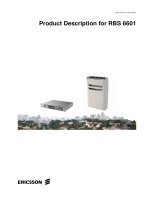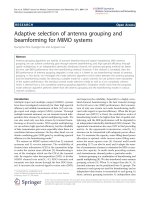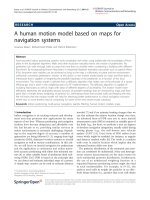SYSTEM DESCRIPTION FOR FGD SYSTEM
Bạn đang xem bản rút gọn của tài liệu. Xem và tải ngay bản đầy đủ của tài liệu tại đây (149 KB, 9 trang )
FOR CONSTRUCTION
0
19.12.2018
Rev
Date
Owner
K.H.KIM
Prepared
T.H.HAN
Checked
H.M.LEE
Approved
FOR CONSTRUCTION
Details of Revision
Owner’s Engineer
Contractor
DOOSAN HEAVY INDUSTRIES VIETNAM
Sub-Supplier
Project
NGHI SON 2 BOT THERMAL POWER PLANT PROJECT
Title
SYSTEM DESCRIPTION FOR FGD SYSTEM
Document No.
Rev.
NS2-XS00-P0HT-530001
Page-No.
0
8
SYSTEM DESCRIPTION FOR FGD SYSTEM
NS2-XS00-P0HT-530001
RECORD OF REVISION
Rev.
Date
A
02.07.2018
B
24.08.2018
0
19.12.2018
Page Affected
Description of Revision
First Issue
3, 6, 7
Revised as per comment
N/A
Rev.0
1 of 8
SYSTEM DESCRIPTION FOR FGD SYSTEM
NS2-XS00-P0HT-530001
CONTENTS
1.
GENERAL DESIGN DESCRIPTION ............................................................................... 3
1.1.
REFERENCE DOCUMENT .............................................................................................. 3
1.2.
GENERAL DESCRIPTION ............................................................................................... 3
1.3.
PROCESS CHEMISTRY.................................................................................................... 4
1.4.
REAGENT CONDITION ................................................................................................... 5
2.
FLUE GAS SYSTEM .......................................................................................................... 5
2.1.
GAS-GAS HEATER ............................................................................................................ 5
2.2.
DAMPER .............................................................................................................................. 5
3.
ABSORBER SYSTEM ........................................................................................................ 6
3.1.
SLURRY SPRAY AND REACTION TANK .................................................................... 6
3.2.
OXIDATION AIR BLOWER ............................................................................................. 6
3.3.
MIST ELIMINATOR .......................................................................................................... 6
3.4.
GYPSUM BLEED PUMP ................................................................................................... 6
3.5.
EMERGENCY STORAGE TANK .................................................................................... 7
3.6.
ABSORBER AREA SUMP ................................................................................................. 7
4.
LIMESTONE HANDLING SYSTEM ............................................................................... 7
5.
LIMESTONE SLURRY PREPARATION SYSTEM ...................................................... 7
6.
GYPSUM DEWATERING SYSTEM ................................................................................ 7
7.
WASTE WATER DISCHARGE ........................................................................................ 8
8.
GYPSUM DISPOSAL ......................................................................................................... 8
Rev.0
2 of 8
SYSTEM DESCRIPTION FOR FGD SYSTEM
NS2-XS00-P0HT-530001
1.
General Design Description
This document provides the general system description for Wet Limestone Flue Gas
Desulfurization (WLFGD) plant for Nghi Son 2 power Plant (600 MW x 2) utilizes wet
limestone slurry with in-situ forced oxidation (IFO) to produce commercial grade gypsum.
1.1.
Reference Document
1.1.1.
Process Flow Diagram
1.1.2.
NS2-XG07-P0HT-530001
PROCESS FLOW DIAGRAM FOR FGD SYSTEM
NS2-XG07-P0ECD-620001
FLOW DIAGRAM FOR LIMESTONE HANDLING SYSTEM
NS2-XG07-P0ECE-620001
FLOW DIAGRAM FOR GYPSUM HANDLING SYSTEM
Piping & Instrument Diagram
NS2-XG02-P1HT-530100
1.2.
P&I DIAGRAM FLUE GAS SYSTEM - FLUE GAS PATH
NS2-XG02-P1HT-530101
P&I DIAGRAM FLUE GAS SYSTEM - DAMPER
NS2-XG02-P1HT-530200
P&I DIAGRAM ABSORBER & AUX.SYSTEM(1/4) - ABSORBER LIQUID SIDE SHEET(1/2)
NS2-XG02-P1HT-530201
P&I DIAGRAM ABSORBER & AUX.SYSTEM(2/4) - ABSORBER LIQUID SIDE SHEET(2/2)
NS2-XG02-P1HT-530202
P&I DIAGRAM ABSORBER & AUX.SYSTEM(3/4) - EMERGENCY STORAGE TANK
NS2-XG02-P1HT-530203
P&I DIAGRAM ABSORBER & AUX.SYSTEM(4/4) - ABSORBER SLURRY SUMP
NS2-XG02-P1HT-530204
P&I DIAGRAM OXIDATION AIR SYSTEM - OXIDATION AIR BLOWER
NS2-XG02-P0HT-530301
P&I DIAGRAM LIMESTONE PREPARATION SYSTEM(1/3) - WET BALL MILL A
NS2-XG02-P0HT-530302
P&I DIAGRAM LIMESTONE PREPARATION SYSTEM(2/3) - WET BALL MILL B
NS2-XG02-P0HT-530303
P&I DIAGRAM LIMESTONE PREPARATION SYSTEM(3/3) - L/S SLURRY STORAGE TANK
NS2-XG02-P0HT-530400
P&I DIAGRAM GYPSUM DEWATERING SYSTEM(1/5) - GYPSUM SLURRY STORAGE TANK
NS2-XG02-P0HT-530401
P&I DIAGRAM GYPSUM DEWATERING SYSTEM(2/5) - DEWATERING SYSTEM "A"
NS2-XG02-P0HT-530402
P&I DIAGRAM GYPSUM DEWATERING SYSTEM(3/5) - DEWATERING SYSTEM "B"
NS2-XG02-P0HT-530403
P&I DIAGRAM GYPSUM DEWATERING SYSTEM(4/5) - FILTRATE TANK
NS2-XG02-P0HT-530404
P&I DIAGRAM GYPSUM DEWATERING SYSTEM(5/5) - FGD W.W Blowdown Tank
NS2-XG02-P0HT-530600
P&I DIAGRAM MAKE UP WATER SUPPLY SYSTEM FOR FGD
NS2-XG02-P0HT-530700
P&I DIAGRAM CLOSED COOLING WATER SYSTEM FOR FGD
NS2-XG02-P0HT-530810
P&I DIAGRAM SERVICE AIR SYSTEM FOR FGD
NS2-XG02-P0HT-530800
P&I DIAGRAM INSTRUMENT AIR SYSTEM FOR FGD
NS2-XG02-P0HT-530900
P&I DIAGRAM AUX. STEAM SYSTEM FOR FGD
NS2-XG02-P0ECD-620001
P&I DIAGRAM FOR LIMESTONE HANDLING SYSTEM
NS2-XG02-P0ECE-620001
P&I DIAGRAM FOR GYPSUM HANDLING SYSTEM
General Description
An absorber is provided for each of the two boiler CID fans. The flue gas from CID fans flows
through the one inlet duct and the open-spray-tower absorber to the stack. A regenerative gas
heat exchangers(GGH) are used to reheat the treated flue gas up to 80℃at 100%TMCR Design
Coal Load(Guarantee Condition).
The flue gas desulfurization system(FGD) is installed for the boiler to meet the required emission
limit of 200mg SO2 / Nm3 @ 6%O2, dry for the range of coal. One spray bank is installed as
Rev.0
3 of 8
SYSTEM DESCRIPTION FOR FGD SYSTEM
NS2-XS00-P0HT-530001
online backup. Gypsum slurry produced in the absorber is concentrated by the gypsum
dewatering system – hydrocyclone. The concentrated gypsum slurry underflow from the gypsum
dewatering hydrocyclone is fed to a vacuum belt filter directly to produce commercial grade
gypsum with less than 13% moisture. The overflow from the gypsum dewatering hydrocyclone
containing the valuable unreated limestone is returned to the absorber. The filtrate receiver water
is sent to filtrate tank to make up for absorber & limestone preparation system.
1.3.
Process Chemistry
The main function of the absorber is to remove sulfur dioxide from the flue gas using a slurry pH
5.0 to 6.0 containing calcium carbonate. The absorber reaction tank is designed to promote
calcium carbonate dissolution and forced oxidation.
The overall reactions that take place in the absorber are :
SO2 (g) + CaCO3 + 2H2O + 1/2 O2 → CaSO4∙ 2H2O + CO2 (g)
Many intermediate steps also take place. Calcium ions are formed in the aqueous solution.
CaCO3 (s) → CaCO3 (aq)
CaCO3 (aq) + H2O → Ca2+ + HCO3 + OHThe SO32- anions form at the flue gas / liquid interface in the absorber.
SO2 (g) → SO2 (aq)
SO2 (aq) + H2O → H2SO3 → HSO3- + H+
HSO3‐ → H+ + SO3‐
Gypsum, calcium sulfate di‐hydrate, is formed by forced oxidation environment.
SO32‐ + 1/2 O2 → SO42‐
2H+ + HCO3‐ + OH‐ → 2H2O + CO2
Ca2+ + SO42‐ + 2H2O → CaSO4·2H2O (s)
The sulfite ion also combines with the calcium ion to form calcium sulfite hemihydrate.
Ca2+ + SO32‐ + 1/2 H2O → CaSO3·1/2 H2O (s)
In addition to sulfur dioxide, the absorber also removes hydrogen chloride and hydrogen fluoride
from the flue gas.
Calcium carbonate is required to neutralize these acid gases in the following manner.
2HCl + CaCO3 → CaCl2 + H2O + CO2
2HF + CaCO3 → CaFl2 + H2O + CO2
Rev.0
4 of 8
SYSTEM DESCRIPTION FOR FGD SYSTEM
NS2-XS00-P0HT-530001
1.4.
Reagent Condition
The Lime Stone Analysis for design is shown in below Table.
<Limestone Mine Survey Result and Specific Design Range>
Trung Nam ①
Fecon Hai Dang ②
Licogi 13 ③
Design
Range
Min
Max
Average
Min
Max
Average
Min
Max
Average
CaO
50.12
54.49
53.26
53.69
55.41
54.72
53.58
54.78
54.36
CaCO3
89.5
97.3
95.13
95.88
98.95
97.71
95.68
97.82
97.08
95.13
85.00
Min
MgO
0.6
4.44
2.02
0.30
2.60
1.11
0.75
1.40
1.06
2.02
4.73
Max
MgCO3
1.26
9.32
4.24
0.63
5.46
2.33
1.58
2.94
2.23
4.24
9.32
Max
SiO2
0.17
0.9
0.46
0.08
1.14
0.45
0.24
0.68
0.36
0.46
1.14
Max
Fe2O3
0.1
0.48
0.20
Al2O3
0.11
0.23
0.18
0.01
0.05
0.03
0.05
0.11
0.07
Al2O3+Fe2O3
0.21
0.71
0.38
0.01
0.05
0.03
0.05
0.11
0.07
0.38
0.71
Max
P2O5
0.043
0.089
0.064
0.009
0.032
0.017
0.003
0.008
0.005
0.064
0.089
Max
- Bond work index : 10kWh/Mt(estimated)
- Solid limestone(bulk density) : 1,120 Kg/m3
- Solid limestone(for equipment and steel structure) : 1,760 Kg/m3
- Solid limestone size : 0-25mm
2.
Flue Gas System
Flue gas from the boiler CID fans will be transferred to one (1) GGH (untreated side). The flue
gas will then enter the absorber where SO2 is removed. And then, from absorber, treated flue gas
will flow via the GGH treated side to the stack.
2.1.
Gas-Gas Heater
Flue gas treated by the absorber system will be reheated to prevent visible plume and corrosion
of duct and stack and to improve the diffusion efficiency into the atmosphere. The GGH is
capable of reheating the treated flue gas temperature at the stack inlet without supplemental heat
input.
2.2.
Damper
One (1) FGD inlet damper, one (1) FGD outlet damper, one (1) emergency bypass damper and
associated damper seal air fans are supplied per unit. Inlet damper is equipped with motorized
actuator. Outlet dampers are also equipped with a motorized actuator. Bypass damper is fail
open with pneumatic actuator.
Rev.0
5 of 8
SYSTEM DESCRIPTION FOR FGD SYSTEM
NS2-XS00-P0HT-530001
3.
Absorber System
Flue gas enters the absorber near the bottom of the spray-tower and flow upward to react with a
descending spray of finely divided droplets of recycle slurry counter-currently. The slurry
contains the alkali needed to react with SO2
Intimate contact of the flue gas with the alkaline limestone slurry is achieved in three successive
spray zones. Each spray bank is provided with a series of spray nozzles designed to achieve
proper atomization of slurry.
3.1.
Slurry Spray and Reaction Tank
Absorber recirculation pumps designed at FGD design point (BMCR Worst Coal Condition) are
supplied. Four(4) absorber recirculation pumps are installed per each unit. Three(3) number of
absorber recirculation pumps will be operated and one(1) number of absorber recirculation pump
is for stand‐by. Each pump is dedicated to each spray stage. The absorber reaction tank is
designed with a minimum of 15.0 hours solids retention time and adequate agitation to ensure
optimum utilization of limestone and crystallization as well as precipitation of gypsum.
3.2.
Oxidation Air Blower
Oxidation of calcium sulfite to calcium sulfate or gypsum is also accomplished in the reaction
tank. Oxidation air blowers supply the air to lances submerged in the recycle tank for the
oxidation reaction. Three(3) (100% x 3) oxidation air blowers are provided for the two(2) units.
The compressed oxidation air is quenched with adequate amount of raw water to avoid nozzle
plugging.
3.3.
Mist Eliminator
A two-stage mist eliminator is provided after slurry spray zone, at the top of the absorber. The
first stage mist eliminator removes the bulk of the entrained liquid droplets from the gas stream.
The mist eliminators are washed intermittently to maintain clean surfaces and low gas-side
pressure losses. Mist eliminator wash nozzles are located in the bottom and the top of the first
stage mist eliminator and the bottom of the second stage mist eliminator. The frequency of the
washing cycle is adjustable and is controlled based on the system water demand. A mist
eliminator wash will utilize the make-up water coming from make up water tank.
3.4.
Gypsum Bleed Pump
Gypsum slurry pump is provided to maintain 20% suspended solids in the absorber. The bleed is
sent to a gypsum dewatering system. The emergency slurry tank is provided for the absorber’s
slurry return or gypsum system return for maintenance situation.
Rev.0
6 of 8
SYSTEM DESCRIPTION FOR FGD SYSTEM
NS2-XS00-P0HT-530001
3.5.
Emergency Storage Tank
One emergency storage tank is provided for both FGD system. The emergency storage tank is
equipped with an emergency tank pump to reclaim to collected slurry from the emergency
storage tank to absorber reaction tank. Agitators are provided to keep the slurry solid in
suspending during tank usage.
3.6.
Absorber Area Sump
Drainage and flush water from pumps will be collected in the absorber area sump through
trenches. An absorber slurry sump and absorber area sump pumps is provided for one absorber
system. An agitator is provided to keep the slurry solid in suspension during tank usage. The
collected slurry in the absorber area sump will be returned to the absorber reaction tank or to the
emergency storage tank.
4.
Limestone Handling System
25mm size of crushed limestone is delivered to the limestone storage shed by truck. The capacity
of limestone storage shed was designed to hold 3 days of limestone consumption and in addition
two(2) limestone day silos is capable of holding total two(2) days of limestone consumption for
two(2) units. Limestone from the storage shed is delivered to day silos by unloading hopper,
bucket elevators and conveyors.
5.
Limestone Slurry Preparation System
The limestone slurry preparation system includes a ball mill and cyclone classifiers which
produce a finely ground limestone slurry at 95% solids passing through 325 mesh. The mill
slurry tank will send limestone to ball mill classifier to classify big size limestone. Then, the
overflow of the ball mill classifier shall go to the central slurry tank. Limestone slurry in the
limestone slurry tank will be pumped to absorber by the limestone slurry transfer pumps.
Agitators is provided to keep the slurry solids in suspension during tank usage.
Limestone slurry is added to the absorber to replenish limestone consumed by chemical reaction
with the absorbed sulfur dioxide. The slurry addition rate is controlled by a pH control system
based on the pH in the absorber.
6.
Gypsum Dewatering System
A stream of slurry is taken from the absorber by gypsum slurry pump to remove the gypsum
produced as a result of SO2 absorption and oxidation. The gypsum bleed from the absorber is fed
to the hydrocyclone. Hydrocyclone underflow gose to the vacuum belt filter. Gypsum cake
including maximum 13% water content is produced at the vacuum belt filter. Vacuum belt filter
system is consist of vacuum receiver, vacuum pump, cake washing system and cloth washing
system. Produced gypsum is transferred and stored to sypsum storage shed.
Rev.0
7 of 8
SYSTEM DESCRIPTION FOR FGD SYSTEM
NS2-XS00-P0HT-530001
Separated water by vacuum belt filter, overflow of the first hydro‐cyclone and underflow of the
second hydro‐cyclone are collected to filtrate water tank. This filtrate water is returned to the wet
ball mill system and absorber. With this flow, unreacted limestone is sent to the absorber reaction
tank to increase limestone utilization.
7.
Waste Water Discharge
Overflow from first hydro‐cyclone is fed to second hydro‐cyclone and filtrate water tank. The
overflow of second hydrocyclone goes to waste water blow down tank. This waste water of FGD
system is discharged to FGD waste water treatement system. By this discharge flow, chloride
concentration in FGD system can be controlled less than 20,000 ppm.
8.
Gypsum Disposal
The gypsum containing less than 13% moisture will be discharged from vacuum belt filter to the
gypsum conveyor. This dewatered gypsum is transported to the gypsum storage shed. The
gypsum is temporarily stored in the gypsum shed discontinuously transported to outside of site
by owner.
Rev.0
8 of 8









